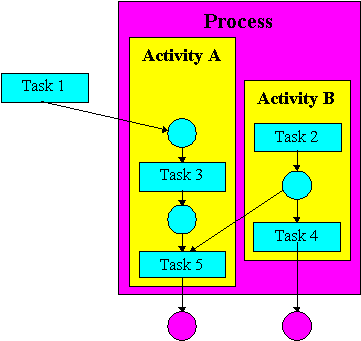
To many people, the words "outsourcing", "contracting" (or "contracting out") and "facilities management" are interchangeable. Actually, there is a considerable difference between
the three, not just in terms of a pure definition of what they are, but also in the ways in which they can be implemented and in
their impacts upon the organization.
The major difference can be explained by the following diagram.

Figure 1.1: Processes, activities and tasks
The diagram shows a business process which consists of two activities, A and B, each of which produces one of the process outputs, shown by the circles. Each of the activities consists of a number of tasks, some of which produce intermediate outputs for use by other tasks, and some of which the produce the final process outputs. (In reality, there are likely to be more activities and tasks and more intermediate outputs, and there may be more complex interactions between the tasks and activities. This simple process will serve as an example to illustrate the difference between outsourcing and contracting out.)
Contracting
Contracting is concerned with taking individual tasks and moving them beyond the organization, so that Task 1 may be contracted out. The responsibility for Activity A and the overall process remains with the organization. The management infrastructure surrounding Task 1 will probably remain within the organization as well.

Figure 1.2: Contracting out tasks
When Task 1 is moved beyond the organization to a contractor, its output still has to return to the organization,
to be used in Task 3.
If Task 3 was also contracted out, then the intermediate output from Task 1 would probably not
have to return to the organization when it has been completed. That is because Tasks 1 and 3 lie on a single flow line.
The
situation is more complex when we consider contracting out Task 2. While Task 2 remains in-house, its output can easily be
duplicated to be used by Tasks 4 and 5:
- A printed report may be circulated or photocopied.
- An electronic document can be held in a central database.
- A manufactured part can be produced in sufficient quantities as raw materials for the subsequent tasks.
When Task 2 moves beyond the organization to a contractor, then additional flows of information are needed.
- A printed report would have to be copied and despatched. Checks on its delivery would have to be instituted.
- For electronic documents, the organization and its contractor may need shared databases or access to each other's systems.
- For manufactured parts, additional current and forecast inventory information would be passed between the organization and the contractor, possibly also necessitating shared databases and access to each other's systems.
Outsourcing
Outsourcing supports the entire process, so that the organization will not need to track progress
on the intermediate tasks and their products. Indeed, the outsourcer may completely re-engineer the activities, tasks and
intermediate products within the process.
It is possible to outsource activities rather than processes, but this is usually only
possible when the activities produce a limited number of products, and where there are no interdependencies of intermediate
products between activities. The activities in the diagram would therefore not be suitable for individual outsourcing. In some
industries, such as car assembly, it is entirely possible to outsource the production of a large number of individual parts, from
door-handles to entire engine assemblies, because they interact in simple flows with the production line. In other industries,
considerable re-engineering may be needed before this can be achieved.
Facilities management
Facilities management differs from outsourcing in that the resources required to
complete the processes remain in the possession of the organization.
For IS outsourcing, the outsourcer will take over the
computer hardware, software and networks, and often the buildings and people as well.
For IS facilities management, the
hardware, software and networks remain with the organization, and often only people are transferred to the facilities manager.
The facilities manager does accept some risk (such as guaranteeing performance and availability), while a contractor usually
does not.
For IS contracting, the emphasis is usually upon individual applications, such as payroll, which are often
"stand-alone".
This distinction between outsourcing, facilities management and contracting certainly provides a
difference in scale and level, but, more importantly, it also provides a difference in approach.
Individual tasks will be
rigorously designed, with clear descriptions of what exactly needs to be done to complete them. Processes are defined in
terms of what they produce, which implies that their definition is less precise. Therefore, a contractor or facilities manager will
almost certainly have to perform tasks in a prescribed manner. An outsourcer may complete the process in any way, provided
that the required outputs are generated. This perception of the difference between outsourcing and the other two is reinforced
by the language used to describe what happens: in contracting and facilities management, the task is performed; in
outsourcing, the process is completed. The emphasis is either on doing something, by performing the task, or on
achieving something, by completing the process.
Copyright © 1996-2025